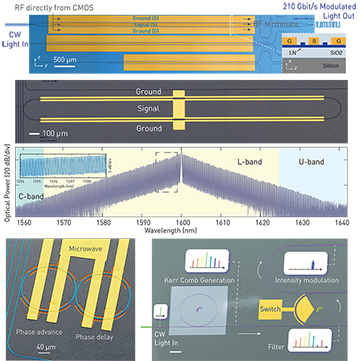 Top: Electro-optic LN modulators that operate at CMOS-compatible voltages. Middle: Resonant LN electro-optic comb generator that creates more than 900 comb lines. Bottom left: An electrically programmable LN photonic molecule. Bottom right: An LN photonic circuit that generates, filters and modulates a Kerr comb all in one chip. [Enlarge figure]
Top: Electro-optic LN modulators that operate at CMOS-compatible voltages. Middle: Resonant LN electro-optic comb generator that creates more than 900 comb lines. Bottom left: An electrically programmable LN photonic molecule. Bottom right: An LN photonic circuit that generates, filters and modulates a Kerr comb all in one chip. [Enlarge figure]
Lithium niobate (LN) can be found almost everywhere in optoelectronics—electro-optic modulators made of LN are a workhorse of optical-fiber communications; periodically poled LN (PPLN) crystals are essential for efficient nonlinear wavelength conversion. However, the notoriously difficult dry etching required means that LN optical devices still cannot be densely integrated, and thus remain bulky, discrete, expensive and rather inefficient. As a result, LN is perceived as a material that has excellent properties—but one that is completely incompatible with modern nanophotonic technologies.
In 2017, we developed an optimized nanofabrication process for realizing nanophotonic LN waveguides with a 0.027-dB/cm optical loss, planting a seed to challenge the status quo.1 In the past year, that seed has blossomed into a variety of integrated LN photonic devices with performances superior to those of other nanophotonic platforms.
In one demonstration, we combined low-loss LN photonic waveguides with high-speed microwave transmission lines to realize a nanophotonic version of LN modulators.2 The dramatically enhanced electro-optic interaction strength allowed these nanophotonic modulators to operate at a CMOS-compatible drive voltage while transmitting data at 210 Gbit/s, significantly pushing the performance envelope of LN modulators.
We also showed that this high-speed, low-voltage modulation scheme can be further integrated with an ultrahigh-Q microresonator.3 By matching the modulation frequency with the microresonator’s free spectral range (FSR), we generated a broadband frequency comb that consists of 900 lines (spaced by 10 GHz) spanning 80 nm in the telecom band. In contrast to other χ(3) (Kerr)-based micro-combs, our comb is based on the χ(2) (electro-optic) nonlinearity and thus is more stable, more frequency-agile and easier to generate.
In the ultimate limit of electro-optic conversion process, a single microwave photon could modulate an optical signal, enabling coherent microwave-to-optical transduction of quantum information. Toward this goal, we have demonstrated a photonic molecule, consisting of a pair of coupled LN microresonators, that supports coherent dynamic manipulation of photonic energy states using external microwave signals.4
We believe that further developments of LN devices with engineered linear, electro-optic, piezo-electric and nonlinear properties, and their monolithic integration into complex photonic networks will lead to a major paradigm shift in integrated photonics. A recent proof-of-concept demonstration performed the generation, filtering and modulation of a Kerr frequency comb all in one LN chip.5 The commercial potential of integrated LN photonic technology is being explored by HyperLight Corp., a VC-backed startup cofounded by the coauthors.
Researchers
Cheng Wang, City University of Hong Kong, Hong Kong
Mian Zhang, HyperLight Corporation, Cambridge, Mass., USA
Marko Lončar, Harvard University, Cambridge, Mass., USA
References
1. M. Zhang et al. Optica 4, 1536 (2017).
2. C. Wang et al. Nature 562, 101 (2018).
3. M. Zhang et al. Nature 568, 373 (2019).
4. M. Zhang et al. Nat. Photonics 13, 36 (2019).
5. C. Wang et al. Nat. Commun. 10, 978 (2019).

